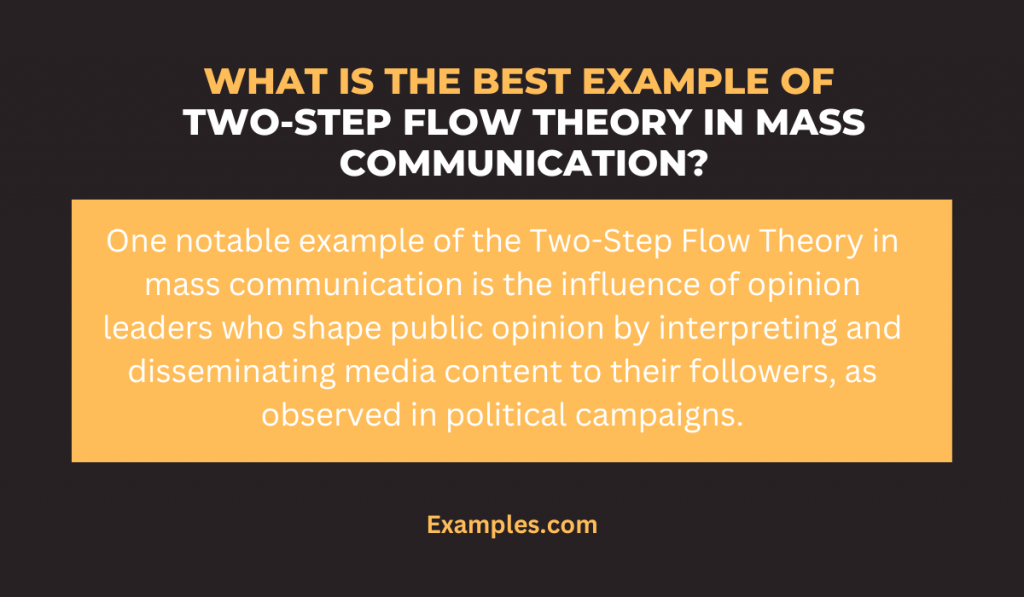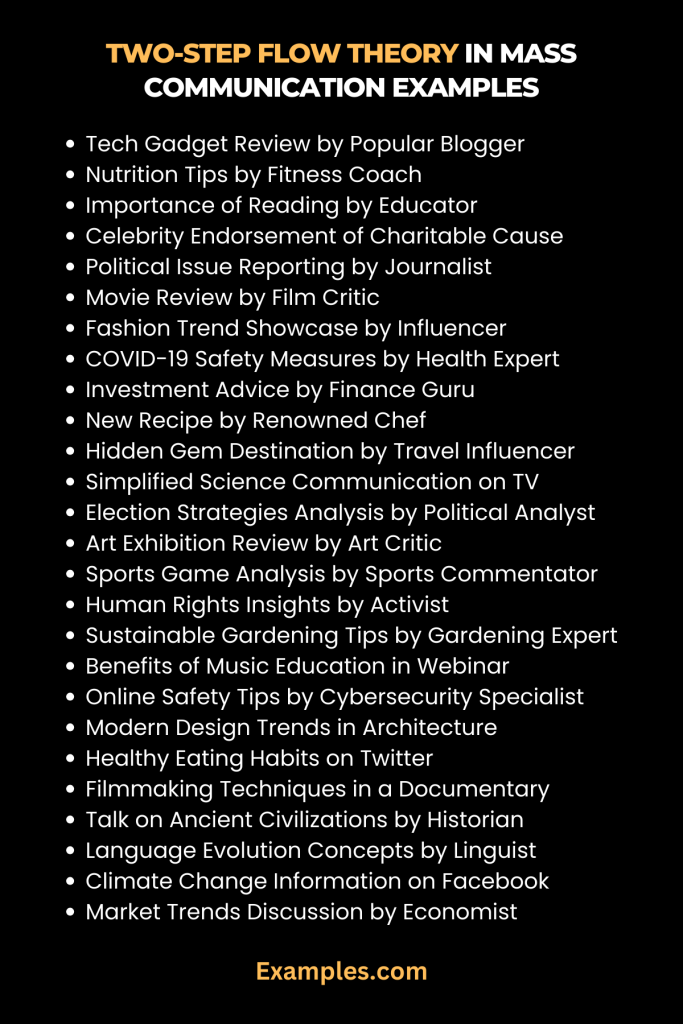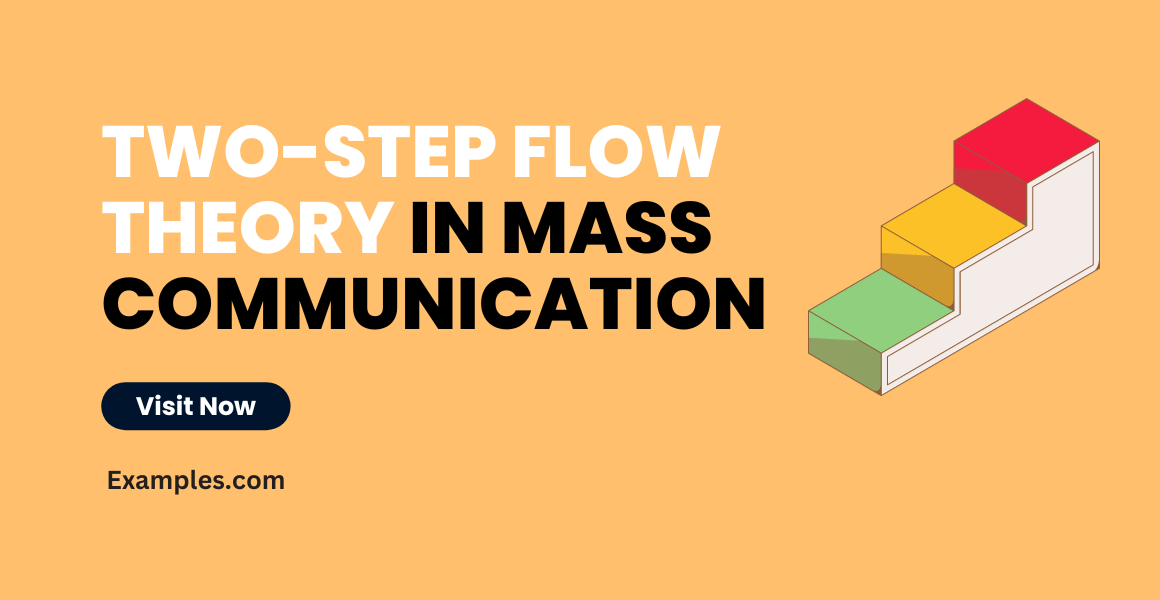29+ Two-Step Flow Theory in Mass Communication Examples
Delve into the Two-Step Flow Theory in Mass Communication, a pivotal concept shaping modern media landscapes. This guide illuminates how opinions and information flow from media to opinion leaders, and then to a wider audience. Discover Mass Communication Examples in Journalism and Mass Communication in Real Life, showcasing the theory’s relevance and impact. This comprehensive overview blends theory with practical instances, providing an insightful look into the intricate mechanics of mass communication.
What is Two-Step Flow Theory in Mass Communication?
The Two-Step Flow Theory is a fundamental concept in the realm of mass communication. This theory suggests that information from the media moves in two distinct stages. First, it reaches “opinion leaders,” individuals who are highly engaged with the media content, such as Social media Mass Communication experts or Journalism Mass Communication professionals. These opinion leaders then act as intermediaries, passing on the information to others in their social circles.
Unlike the direct influence model, where media impacts the audience directly, the Two-Step Flow Theory emphasizes the role of these opinion leaders. They filter, interpret, and personalize the information before it reaches the wider audience. This approach highlights the less direct but significant influence of mass media and underscores the importance of personal communication in shaping public opinion.
In essence, the Two-Step Flow Theory in mass communication demonstrates how media effects are not always direct and straightforward but can be mediated through interpersonal channels, making it a critical concept in understanding the dynamics of communication in today’s interconnected world.

History
The Two-Step Flow Theory, a pivotal concept in the field of mass communication, revolutionized how we understand the dissemination and impact of media messages. Originating in the mid-20th century, this theory challenged the previously dominant Hypodermic Needle Theory, which suggested a direct, powerful influence of media on the masses. The Two-Step Flow Theory introduced a more nuanced view, recognizing the role of opinion leaders in the process of media influence.
Origin and Development
The theory was first introduced by sociologists Paul Lazarsfeld, Bernard Berelson, and Hazel Gaudet in their 1944 study of the 1940 U.S. Presidential election. This landmark study observed that people are more likely to be influenced by other individuals, whom they regard as opinion leaders, rather than directly by mass media content. These opinion leaders filter and interpret media messages, subsequently affecting the attitudes and behaviors of their social networks.
Key Principles
The Two-Step Flow Theory rests on two primary principles:
- Media to Opinion Leaders: The first step involves mass media disseminating information to opinion leaders. These individuals actively consume Mass Communication Examples in Journalism and other media forms, forming their interpretations and opinions.
- Opinion Leaders to the Public: In the second step, these opinion leaders act as intermediaries, passing on their interpretations to a wider audience. This audience tends to have less direct contact with the media sources but trusts the opinion leaders within their personal networks.
Impact on Mass Communication
This theory significantly impacted the understanding of Mass Communication Characteristics, especially in the realms of Public Relations Mass Communication and advertising. It highlighted the importance of targeting opinion leaders to effectively influence public opinion and behavior. The theory also contributed to the evolution of media research, leading to a more sophisticated understanding of the media-audience relationship.
Modern Relevance
In the digital age, the Two-Step Flow Theory remains relevant, particularly with the rise of social media influencers and content creators. These modern opinion leaders often shape public opinion through platforms like Social media Mass Communication, blogs, and vlogs. The theory has adapted to these new forms of media, illustrating its enduring influence in understanding mass communication dynamics.
What is the Best Example of Two-Step Flow Theory in Mass Communication?
The Two-Step Flow Theory in mass communication, a pivotal concept in understanding how information travels in society, posits that ideas flow from mass media to opinion leaders, and from them to a wider population. This theory, significantly different from the direct influence models like the Hypodermic Needle Theory, emphasizes the role of influential individuals or groups in shaping public opinion.
One of the best examples of the Two-Step Flow Theory in action is seen in Social media Mass Communication. Social media platforms have revolutionized how information is disseminated, making them ideal case studies for this theory. A clear instance is the role of influencers in marketing and opinion shaping. Brands often use popular social media personalities to promote products or ideas. These influencers, considered opinion leaders, have a significant impact on their followers’ attitudes and behaviors, effectively demonstrating the Two-Step Flow Theory. Their followers, in turn, spread these ideas further within their circles, exemplifying the secondary flow of information.
Another pertinent example lies in Journalism Mass Communication. Renowned journalists or news anchors often serve as opinion leaders. Their interpretations and opinions about news events can significantly influence public perception. For instance, during an election, a respected journalist’s analysis of a political debate might shape the audience’s views more profoundly than the debate itself. This scenario shows how information from the mass media (the debate) is filtered and mediated by opinion leaders (journalists) before reaching the general public.

30 Two-Step Flow Theory in Mass Communication Examples
The Two-Step Flow Theory in Mass Communication emphasizes the influence of opinion leaders in shaping public opinion. This model highlights the pivotal role of interpersonal relationships in the dissemination of information, distinguishing it as a key component in Mass Communication Examples and Mass Communication Characteristics. It challenges the direct effects model, suggesting that media messages pass through a two-step process, first to opinion leaders and then to a wider audience. This theory is vital in understanding the dynamics of Social media Mass Communication and Journalism Mass Communication.

- A popular blogger reviews a new tech gadget. Their followers, influenced by the review, spread the word further among their circles.
- A local community leader advocates for environmental conservation on social media. Their message reaches community members who then share it with their families and friends.
- A fitness coach shares nutrition tips online. Enthusiasts follow these tips and recommend them to peers seeking health advice.
- An educator discusses the importance of reading in a webinar. Parents attending the webinar encourage reading habits in their children.
- A celebrity endorses a charitable cause on television. Fans become aware and contribute to the cause, extending the reach of the message.
- A journalist reports on a political issue. Viewers discuss this with their colleagues, thereby influencing opinions in their workplace.
- A film critic shares a movie review on a podcast. Moviegoers listen and recommend the film to their friends based on the critique.
- A fashion influencer showcases a new trend on Instagram. Their followers adopt the trend and introduce it to their social groups.
- A health expert discusses COVID-19 safety measures on a news channel. Viewers share this vital information with their communities.
- A marketing professional writes about effective advertising strategies on a blog. Readers apply these strategies in their businesses and share results with peers.
- An automotive expert discusses electric vehicles on a YouTube channel. Car enthusiasts watch and share this information with fellow auto aficionados.
- A finance guru gives investment advice on a radio show. Listeners use these tips and relay them to family members interested in investing.
- A renowned chef posts a new recipe on their blog. Home cooks try the recipe and share their experiences with friends.
- A travel influencer shares a hidden gem destination on their Instagram. Followers then recommend this spot to other travel enthusiasts.
- A science communicator explains a complex theory in a simple manner on TV. Viewers understand and explain the concept to their children or students.
- A political analyst discusses election strategies in a newspaper column. Readers debate these strategies in community gatherings.
- An art critic reviews a new exhibition in a magazine. Art lovers visit the exhibition and recommend it to their peers.
- A sports commentator analyzes a game on a podcast. Fans discuss the analysis in online forums and social media groups.
- A human rights activist shares insights on a talk show. Viewers are moved and discuss these issues in social settings.
- A business leader writes about leadership qualities in an online article. Aspiring entrepreneurs read and discuss these qualities in business workshops.
- A gardening expert shares sustainable gardening tips on a blog. Home gardeners implement these tips and share their experiences with neighbors.
- A music teacher discusses the benefits of music education in a webinar. Parents watch and encourage music learning in their children.
- A cybersecurity specialist talks about online safety on a podcast. Tech enthusiasts listen and share the tips with less tech-savvy friends.
- An architect explains modern design trends in a magazine. Readers interested in home renovation discuss these trends with architects.
- A nutritionist posts about healthy eating habits on Twitter. Health-conscious followers retweet and share these habits with their families.
- A film director discusses filmmaking techniques in a documentary. Aspiring filmmakers watch and share insights with their film school peers.
- A historian talks about ancient civilizations on a TV program. History buffs watch and share this knowledge in educational settings.
- A linguist writes about language evolution in a book. Language enthusiasts read and discuss these concepts in study groups.
- A climate activist shares information about climate change on Facebook. Concerned citizens read and spread awareness in their local communities.
- An economist discusses market trends on a financial news channel. Investors watch and share this analysis with colleagues in the finance sector.
Role of Two-Step Flow Theory in Mass Communication
The Two-Step Flow Theory is a seminal concept in understanding how information is disseminated and consumed in the realm of Mass Communication. This theory, introduced by Paul Lazarsfeld, Bernard Berelson, and Hazel Gaudet, revolutionized the understanding of media influence and its role in shaping public opinion. Here, we delve into its significance and application in modern mass communication.
Key Principles of Two-Step Flow Theory
- Opinion Leaders as Intermediaries: The theory posits that media messages do not directly influence the general public. Instead, they are filtered through opinion leaders who then pass them on to others. These opinion leaders, with their enhanced exposure to media and greater engagement in community affairs, act as catalysts in the flow of information.
- Indirect Media Influence: Unlike the Hypodermic Needle Theory, which suggests direct influence of media on audiences, the Two-Step Flow Theory argues for an indirect effect. Media impacts opinion leaders first, who in turn influence their social circles.
Impact of Two-Step Flow Theory on Mass Communication
- Understanding Audience Dynamics: This theory helps in comprehending that the audience is not a homogeneous entity. Recognizing the role of opinion leaders allows for more targeted and effective communication strategies.
- Enhancing Media Campaigns: In the context of Public Relations Mass Communication and advertising, understanding this flow is crucial for designing campaigns. Influencing the opinion leaders can lead to a more significant impact on the target audience.
- Shaping Public Opinion: The theory is instrumental in understanding how public opinion is formed, particularly in complex scenarios like political campaigns or public health crises. Opinion leaders play a vital role in interpreting and contextualizing media messages for their peers.
- Adaptation in Digital Age: In the era of Social media Mass Communication, the Two-Step Flow Theory has evolved. Social media influencers and bloggers often act as modern opinion leaders, influencing their followers’ views and decisions.
- Role in Crisis Communication: During crises, reliable information dissemination is critical. Opinion leaders can play a vital role in ensuring accurate information flow, combating misinformation, and shaping public response.
- Influence in Journalism and Broadcasting: Journalists and broadcasters can leverage this theory by targeting opinion leaders with accurate and comprehensive news, thereby influencing the broader public indirectly but effectively.
Importance of Two-Step Flow Theory in Mass Communication
The significance of the Two-Step Flow Theory in the realm of Mass Communication cannot be overstated:
- Identifying Opinion Leaders: Understanding this theory aids in identifying key opinion leaders who act as intermediaries between the mass media and the public.
- Targeted Messaging: It enables the creation of more targeted and effective communication strategies, particularly in Public Relations Mass Communication and advertising.
- Enhancing Media Effectiveness: By recognizing the role of personal relationships in media influence, the theory enhances the effectiveness of media campaigns.
- Societal Impact: The theory underscores the societal impact of mass media, highlighting how media messages can indirectly influence a larger population through opinion leaders.
- Understanding Audience Dynamics: It provides insights into audience dynamics and how people interpret and spread media content within their social circles.
How to use Two-Step Flow Theory in Mass Communication
To effectively utilize the Two-Step Flow Theory in Mass Communication, consider the following steps:
- Identify Opinion Leaders: Analyze your audience to identify potential opinion leaders. These individuals often have a large following on Social media Mass Communication platforms and can influence others’ views and behaviors.
- Engage with Opinion Leaders: Develop relationships with these leaders. Providing them with exclusive information or early access to content can encourage them to share your message with their network.
- Tailor Content for Opinion Leaders: Create content that resonates with opinion leaders. This content should be credible, informative, and align with their interests and values.
- Monitor and Adapt: Keep track of how your message is being received and shared by opinion leaders and their networks. Use this feedback to adapt your communication strategy.
- Leverage Multiple Channels: Utilize various channels of Mass Communication such as blogs, social media, and traditional media to ensure your message reaches opinion leaders across different platforms.
The Two-Step Flow Theory offers profound insights into the nuances of Mass Communication. It emphasizes the pivotal role of opinion leaders as intermediaries in shaping public opinion. For anyone engaged in mass communication, incorporating this theory into strategies is vital for effective message dissemination, making it an indispensable tool in the ever-evolving landscape of media and communication.



